14 Best Places to Eat in Miami Right Now, From Venezuelan Fare to Caribbean BBQ
Though tech bros and sunshine-chasing New Yorkers have been flocking to South Florida, the dynamic forces behind the city’s restaurant scene are decidedly homegrown.
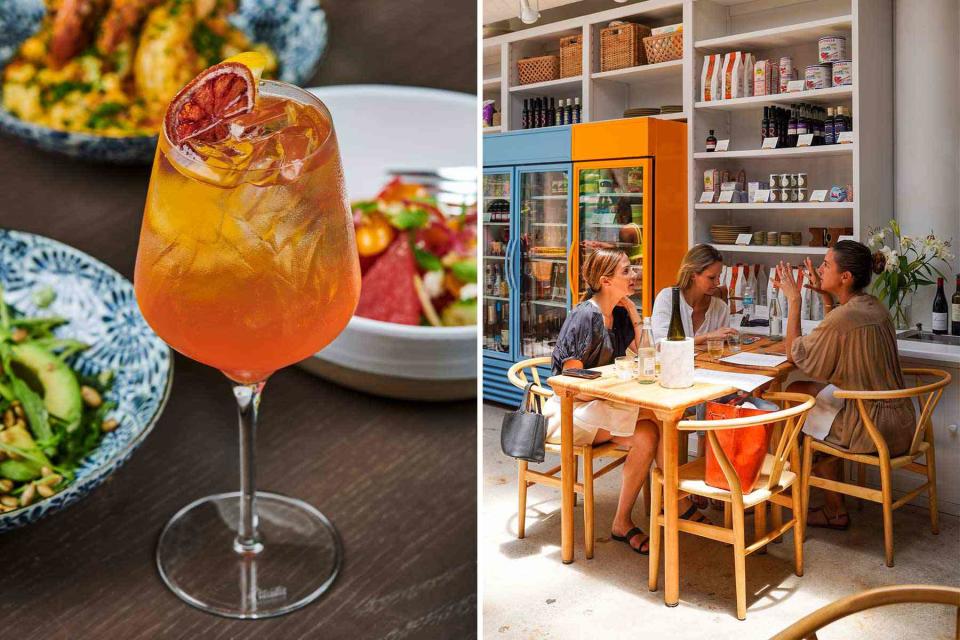
From left: Felipe Cuevas/Courtesy of Thesis Hotel; Vanessa Diaz/Courtesy of Krüs Kitchen
From left: The passion-fruit infused Maracuya Spritz at Mamey, in Coral Gables, Florida; the dining room at Krüs Kitchen.There's a restaurant here?” Perplexed, my driver turns down a street in the North Miami neighborhood of Golden Glades and follows it toward a dead end, a tent, some picnic tables, and a smoker. A canopy of pines and staghorn ferns seems intent on swallowing them all.
There is a restaurant, yes — Drinking Pig BBQ — but only on Sundays. That’s when three chefs — one from St. Croix (Raheem Sealey), one from Venezuela (Yohanir Sandoval), and one from Jamaica (Mark Wint) — get together to form a pop-up in front of Wint’s home, a flan-colored bungalow with a ceramic parrot perched above the address plate. (They met while cooking at the Asian-inspired barbecue restaurant Kyu, in the Wynwood neighborhood.) Over the whir of an industrial fan, Wint unwraps briskets swaddled carefully as babies, while Sandoval bakes buttermilk corn bread. Sealey takes orders and delivers trays heaped with uncommon barbecue that blends American tradition, Caribbean heritage, and fine-dining pedigree.
The trio also runs a Saturday stand at Wynwood’s Smorgasburg Miami, one of the many recent New York–based projects to open in (some say invade) Miami, part of the so-called Great Relocation that brought many pandemic-weary Northerners to South Florida. But do we really need to talk about that? The culinary narrative of the Magic City in this moment needn’t be defined by imports and replications, not when the original content is stronger than ever.
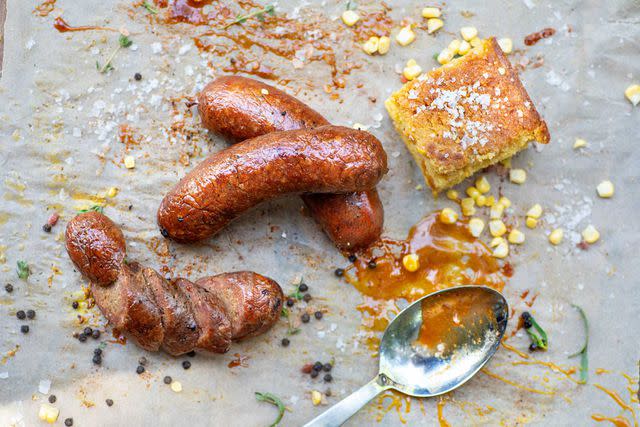
Michelle VanTine/Courtesy of Drinking Pig BBQ
Corn bread and smoked sausages from Drinking Pig BBQ.Do we really need to talk about Manhattan transplant Cote, where I savored an excellent Wagyu rib eye next to a couple bickering over an Instagram bikini photo shoot, when we can talk about its homegrown Design District neighbor, Itamae? When a torrential storm scattered the aspiring influencers to the nearby Gucci and Dior boutiques, I sheltered here, at chef Nando Chang’s six-seat terrazzo-topped bar with lemongrass-perfumed kanpachi tiradito, Hokkaido scallop nigiri dabbed with fruity apple-banana purée, and other vivacious expressions of Japanese-Peruvian Nikkei cuisine.
Do we really need to talk about Carbone — almost as hard to reserve in Miami as it is in New York City — when we can talk about Luca Osteria, where Giorgio Rapicavoli offers his Italian-Argentine family’s sacred tiramisu? “It’s always been my dream to open an Italian restaurant,” Rapicavoli explained. He’s finding, in the wake of the pandemic, that Miami chefs have a mandate to “cook like the best representation of ourselves.”
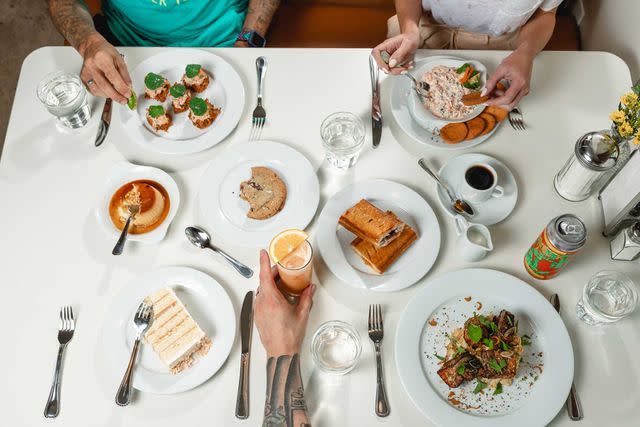
Antonella Re/Courtesy of Chug's Diner
A brunch spread at Chug’s.Let’s talk about Clyde’s Caribbean, where EDM producer Christopher “Jillionaire” Leacock honors his grandfather Clyde’s legacy with Trinidadian classics like lip-stinging jerk-chicken bakes. And sourdough-centric Paradis Books & Bread, with a library of critical readings — a spiritual bulwark against the Florida Department of Education’s book-banning crusade. Let’s talk about those places you might not already know, or at least places my driver wasn’t familiar with.
“It says it’s supposed to be here…” Another day, another driver, who really can’t be blamed for not finding Caracas Bakery in the city of Doral, a mile northwest of Miami International Airport. I join a queue waiting to ogle the counter stacked with gleaming croissants and other goods baked by two generations of the Brazón family. After retiring from corporate security in Venezuela, Manuel Brazón attended and then taught at a culinary school in Caracas before moving to Miami to work at the city’s famed Zak the Baker. Manuel’s son, Jesús, a graphic designer and the two-year-old bakery’s sourdough whisperer, explained: “It was super cool because you had these hip, tattooed people on the counter, and then you see my 56-year-old dad.” Jesús does the breads, Manuel the pastry, and Scarlet Rojas, Jesús’s mother, the cachitos — Venezuelan bread filled with ham and cheese.
The Brazóns helped me start the day the way people should in Miami, with a café con leche and a danish that’s similar to a pastelito de guayaba y queso, recast by the Brazóns with zillion-flake lamination and a big pink pupil of house-made guava preserve. I started the next day the same, with the addition of fresh-squeezed OJ served in a chilled glass, at Chug’s, the Coconut Grove diner. “Chug’s is born from Cuban-American kids like me, who know rice, beans, plantains, and roast pork as much as they know pancakes and breakfast sandwiches,” chef-owner Michael Beltran told me.
Beltran emerged from the kitchen of award-winning chef Michael Schwartz in the mid 2010s, as did Niven Patel, whose restaurant Mamey bewitches with ghee-roasted plantains and honey-glazed lamb ribs. But despite Beltran’s résumé, “People said I was nuts when I opened Ariete six years ago in the Grove,” he says, referring to the contemporary American spot he unveiled in 2016. “That’s where restaurants go to die.”
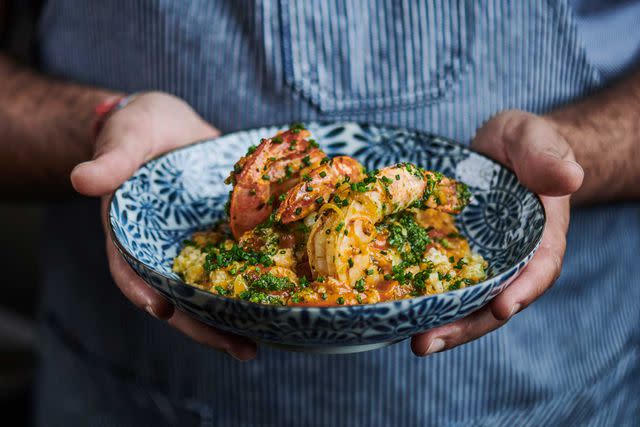
Felipe Cuevas/Courtesy of Thesis Hotel
Shrimp and grits from MameyToday it’s where restaurants go to thrive among the historic villas and centenarian banyan trees. Gone is the Cheesecake Factory. Here are Chug’s and Ariete and Krüs Kitchen, a restaurant-grocery owned by hospitality entrepreneurs Josh Hackler, Pili Restrepo Hackler, and Sebastián Vargas, roosting in an Art Deco mezzanine.
Chef Sebastián Vargas, son of Colombian diplomats, went to high school in India, studied in Paris and New York, and cooked at legendary restaurants in Italy and Sweden. His menu at Krüs reflects that peripatetic history: a caviar-crowned spool of chitarra pasta in a frothy mussel emulsion is brightened with Meyer lemon; tawny coconut rice is layered with sweet crab and feathery marigolds that taste like tangerine. A chef could torture ingredients like this, but these flavors spoke with clarity and joie de vivre. “In Miami, there are not enough casual, uncomplicated places to have amazing food,” Restrepo Hackler said.
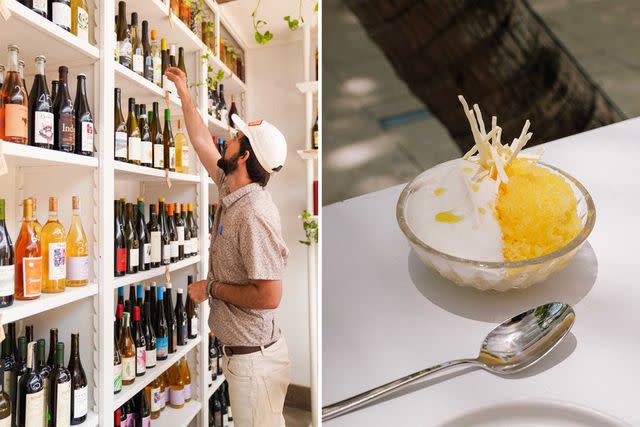
From left: Vanessa Diaz/Courtesy of Krüs Kitchen; James Jackman
From left: Shopping for wine in the market at Krüs Kitchen; a cremolada made with tangerine and green tea at Itamae.This “come as you are” attitude won’t get you into anywhere involving crypto yachts or bottle sparklers, but it’s welcome at Drinking Pig BBQ, where Sealey served me glorious ribs sticky with house-made barbecue sauce; snappy sausages made from pork butt and brisket trim; and Sandoval’s corn bread, almost as moist as tres leches. I’m still stuffed from a late lunch, but the incredible barbecue compels me to clear the tray before I call — and collapse into — a car.
“What’s this, some kind of restaurant?” the driver asks. I sit up straight, slowly, and tell her that it is — and we really need to talk about it.
WHERE TO STAY IN MIAMI
Palihouse Miami Beach hides out on the Intracoastal side of Miami Beach, a strong match for travelers seeking easygoing style over see-and-be-seen gloss. Highlights include big bright bedrooms, a garden oasis of a pool, free bikes, lovely staff, and the house-baked banana bread. But the best amenity may be the location, just two blocks to the beach (but removed from the traffic and crowds) and a quick shot over the bridge to the mainland restaurants in the Design District, Wynwood, and beyond.
The Ritz-Carlton Coconut Grove is the neighborhood's standard bearer of traditional luxury, with a grand, dignified lobby of pillars and palms anchoring understated bedrooms and marble baths. Base yourself here for walkable access to the Grove's fleet of happening restaurants; it's a quick ride to Coral Gables, too.
A version of this story first appeared in the September 2022 issue of Travel + Leisure under the headline "Miami Fresh."

